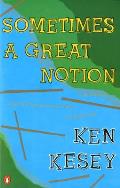
Their natural sibling rivalry is intensified by the fact that Hank slept with Lee’s mother numerous times before she left for the East, and Lee saw them through a hole in his bedroom wall. He is deathly afraid of conflict, of fighting, whereas Hank is always ready to mix it up. His intellectual nature stands in contrast to Hank’s native cunning. As Lee is very good in school, she moves (without Henry) back East with him, where he eventually goes to Yale and then on to graduate school. The new wife, Lee’s mother, did not want Lee to grow up to be a logger. Old Henry married a young woman from the East after his first wife (and Hank’s mother) died.

Hank and Lee share the same father, Old Henry Stamper, who built the logging business that Hank now runs. Leland Stamper (Lee), is Hank’s polar opposite. The Stampers hire only family members to work in their logging operation, so that they don’t have to deal with the union. He is also smart, which sets him apart from the rough and sometimes brutish loggers of the union, with whom he is locked in a war because he is going to fill a contract with the Wakonda Pacific lumber mill, despite the fact that the union loggers are on strike. Blessed with the body of an athlete and backed by the Stamper motto “Never Give a Inch”, he is the driving force behind the Stamper family logging business. Hank and Lee Stamper, the protagonists, are brothers locked in a constant battle of sibling rivalry with psycho-sexual underpinnings. Kesey has a remarkable ear for dialogue and relates the tall tales and anecdotes of his characters such that we feel like we are silent members of the community, sitting around the Stamper kitchen table or in a corner table at the Snag, the town watering hole.Įqually brilliant is the portrayal of his main (as well as secondary) characters. Kesey captures the Oregon loggers and the townspeople of his fictional town of Wakonda with the same brilliance that Faulkner captured the people of Yoknapatawpha County. All along we are pulled through the story by foreshadowing, punctuated by moments of pure joy and moments of pure beauty. Kesey uses these techniques not to jar the reader, but to create a multilayered and organic whole through the strength of his storytelling. The point of view changes from character to character, switching between first person as well as third person narrative. Getting into the mind of the whole town of Wakonda, Oregon (where the main action takes place): the dialogue and internal monologue of everyone from Hank Stamper to the dog Molly is revealed and woven seamlessly into the story.įollowing from an identifiable beginning to an end, the narrative nevertheless jumps forward and backward in time, leaving clues such as letters and a photo album which eventually reveal crucial facts later in the novel. Shifting the action of the story to a completely different character as well as a different locality in just a short piece of dialogue. Kesey pulls out all the stops in this novel: This story of a fight between striking loggers and an independent family logging business takes on mythic dimensions.

The story builds relentlessly from its initial image. Someone is going to lose an arm, or worse, but we keep reading, sometimes afraid of what is going to happen, but unable to stop. The sense of foreboding is set from the beginning and never lets up. Īnd from the very beginning of Sometimes a Great Notion, Ken Kesey’s second novel and eagerly-awaited follow-up to his acclaimed One Flew Over The Cuckoo’s Nest, we are hooked. Twisting and stopping and slowly untwisting in the gusting rain, eight or ten feet above the flood’s current, a human arm, tied at the wrist (just the arm look) disappearing downward at the frayed shoulder where an invisible dancer performs twisting pirouettes for an enthralled audience (just the arm, turning there, above the water)…”.

Then, we notice that a human arm is dangling over the river: Finally, in the foothills, through tamarack and sugar pine, shittim bark and silver spruce - and the green and blue mosaic of Douglas fir - the actual river falls 500 feet … and look: opens out upon the fields.” Then, through bearberry and salmonberry, blueberry and blackberry, the branches crashing into creek, into streams.

The first little washes flashing like thick rushing winds through sheep sorrel and clover, ghost fern and nettle, sheering, cutting … forming branches. First, we are transported to the Oregon Coast:Īlong the western slopes of the Oregon Coastal Range … come look: the hysterical crashing of tributaries as they merge into the Wakonda Auga River …


 0 kommentar(er)
0 kommentar(er)
